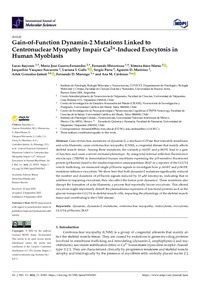Gain-of-function dynamin-2 mutations linked to centronuclear myopathy impair ca2+-induced exocytosis in human myoblasts
Autor
Bayonés, Lucas
Guerra-Fernández, María José
Hinostroza, Fernando
Báez-Matus, Ximena
Vásquez-Navarrete, Jacqueline
Gallo, Luciana I
Parra, Sergio
Martínez, Agustín D.
González-Jamett, Arlek
Marengo, Fernando D.
Cárdenas, Ana M.
Fecha
2022Resumen
Gain-of-function mutations of dynamin-2, a mechano-GTPase that remodels membrane
and actin filaments, cause centronuclear myopathy (CNM), a congenital disease that mainly affects
skeletal muscle tissue. Among these mutations, the variants p.A618T and p.S619L lead to a gain
of function and cause a severe neonatal phenotype. By using total internal reflection fluorescence
microscopy (TIRFM) in immortalized human myoblasts expressing the pH-sensitive fluorescent
protein (pHluorin) fused to the insulin-responsive aminopeptidase IRAP as a reporter of the GLUT4
vesicle trafficking, we measured single pHluorin signals to investigate how p.A618T and p.S619L
mutations influence exocytosis. We show here that both dynamin-2 mutations significantly reduced
the number and durations of pHluorin signals induced by 10 µM ionomycin, indicating that in
addition to impairing exocytosis, they also affect the fusion pore dynamics. These mutations also
disrupt the formation of actin filaments, a process that reportedly favors exocytosis. This altered
exocytosis might importantly disturb the plasmalemma expression of functional proteins such as the
glucose transporter GLUT4 in skeletal muscle cells, impacting the physiology of the skeletal muscle
tissue and contributing to the CNM disease.
Fuente
International Journal of Molecular Sciences, 23(18), 10363Identificador DOI
doi.org/10.3390/ijms231810363Colecciones
La publicación tiene asociados los siguientes ficheros de licencia:


